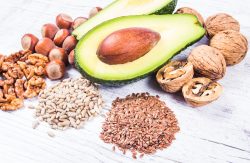Should You Brush or Floss First?
 Brushing removes plaque and food debris, but the bristles of a toothbrush can’t reach deep in between teeth to remove it all. Flossing alone won’t be enough to keep you from getting gum disease and other oral complications because it only removes some of the plaque that has been collected on them throughout the day. In order for a person’s mouth to stay as clean as possible they need both an efficient routine with toothbrush and floss daily. As a result there’s less dental plaque which can lead to gum disease. But, should you brush or floss first?
Brushing removes plaque and food debris, but the bristles of a toothbrush can’t reach deep in between teeth to remove it all. Flossing alone won’t be enough to keep you from getting gum disease and other oral complications because it only removes some of the plaque that has been collected on them throughout the day. In order for a person’s mouth to stay as clean as possible they need both an efficient routine with toothbrush and floss daily. As a result there’s less dental plaque which can lead to gum disease. But, should you brush or floss first?
Some dentists argue that flossing should come first because the brushing action will remove any particles and plaque that have been released and make them easier to brush away with a toothbrush. There are many people who brush their teeth and then floss. The problem with brushing then flossing is that any food, plaque or bacteria released from between your teeth remain in the mouth until next time you brush.
A study was done to evaluate the efficacy of brushing and flossing on reducing dental plaque. After prophylaxis, 25 students discontinued all forms of oral hygiene for 48 hours. The study was performed in two phases with two-week washout intervals. In one phase, they first brushed, then flossed. In the other they used dental floss then brushed.
The researchers found that by using a floss-brush approach, people were able to reduce interdental and whole plaque significantly more than when they used brush and floss. However, there was no evidence of significant difference between groups in areas where marginal plaque had been present before treatment started.
Why is flossing so important? Plaque, the main cause of gum disease can easily harden on your teeth within 24-36 hours if you don’t brush or visit a dentist often enough. But by flossing and then brushing afterwards most people will not have any problems with this.
Maintaining healthy gums ensures that tooth decay won’t have room to grow by providing protection against acids found within foods we eat daily. Gum disease is a serious mouth infection that can destroy your teeth and cause pain. It occurs when there are too many bacteria on the surface of our dental plates This can be caused by not brushing or flossing properly as well as missing routine check-ups with a dentist about once every six months.
The key to preventing dental problems like cavities and gum disease is sticking with a good oral health routine. This includes regularly flossing and brushing your teeth twice per day.
To view the original scientific study click below:
The effect of toothbrushing and flossing sequence on interdental plaque reduction and fluoride retention: A randomised controlled clinical trial



 Electric lights have been a big change in the way we live our lives. It has been only about 130 years ago that they were invented bringing drastic changes to how humans function on a daily basis including our sleep patterns. For those who want better health or just more peace when it comes to sleeping at night make sure there isn’t any light coming into your bedroom. The dark will help you relax faster which leads towards a happier mood overall and improved physical health.
Electric lights have been a big change in the way we live our lives. It has been only about 130 years ago that they were invented bringing drastic changes to how humans function on a daily basis including our sleep patterns. For those who want better health or just more peace when it comes to sleeping at night make sure there isn’t any light coming into your bedroom. The dark will help you relax faster which leads towards a happier mood overall and improved physical health. The blood metabolome is the small molecules found in your bloodstream that can interact with everything from brain function to bodily organs. We’re only just starting to understand the incredible impact our gut microbiome has on shaping molecules found in our blood. Figuring out what governs this variation could pave the way for precision approaches when it comes down to health and disease status.
The blood metabolome is the small molecules found in your bloodstream that can interact with everything from brain function to bodily organs. We’re only just starting to understand the incredible impact our gut microbiome has on shaping molecules found in our blood. Figuring out what governs this variation could pave the way for precision approaches when it comes down to health and disease status. If you’re one of the millions of Americans who suffer from chronic constipation, relief may be closer than you think. According to a recent study, 16% of Americans have chronic constipation, and the odds rise to 33% for ages 60 and over. A recent study shows this unpleasant problem may have a pleasant solution.
If you’re one of the millions of Americans who suffer from chronic constipation, relief may be closer than you think. According to a recent study, 16% of Americans have chronic constipation, and the odds rise to 33% for ages 60 and over. A recent study shows this unpleasant problem may have a pleasant solution.  Intensive physical therapy and stem cell grafts together can boost the functionality of spinal cord injuries more than either treatment alone. Researchers found this in animal models, where tissue growth, repair, and functionality were increased following the combination of therapies. The stem cells promote growth and healing of the surrounding tissues, while the physical therapy helps to improve movement and function.
Intensive physical therapy and stem cell grafts together can boost the functionality of spinal cord injuries more than either treatment alone. Researchers found this in animal models, where tissue growth, repair, and functionality were increased following the combination of therapies. The stem cells promote growth and healing of the surrounding tissues, while the physical therapy helps to improve movement and function.  If you’re looking to improve your muscular strength without the need for exercise, then this is good news! Green leafy vegetables are a great source of nitrates, and just one cup per day can provide a significant boost in muscle function.
If you’re looking to improve your muscular strength without the need for exercise, then this is good news! Green leafy vegetables are a great source of nitrates, and just one cup per day can provide a significant boost in muscle function. A team of researchers have discovered some key contributors that encourage human stem cell reprogramming to the naive state. This can be utilized to model early stages of development and will help scientists generate naive pluripotent stem cells quickly and efficiently. The discovery will help provide new understanding into the systems that reconfigure and destabilize cell identity involved in transitioning states of cells. The team learned more about reprogramming of naive stem cells after a genome wide function screen.
A team of researchers have discovered some key contributors that encourage human stem cell reprogramming to the naive state. This can be utilized to model early stages of development and will help scientists generate naive pluripotent stem cells quickly and efficiently. The discovery will help provide new understanding into the systems that reconfigure and destabilize cell identity involved in transitioning states of cells. The team learned more about reprogramming of naive stem cells after a genome wide function screen.  Heart disease is a leading cause of death in the United States, so it’s important to know which foods can help reduce the risk. A new research review has found that the major plant-based version of the nutrient omega-3 fatty acid, alpha-linolenic acid (ALA), can benefit heart health and reduce the risk of heart disease.
Heart disease is a leading cause of death in the United States, so it’s important to know which foods can help reduce the risk. A new research review has found that the major plant-based version of the nutrient omega-3 fatty acid, alpha-linolenic acid (ALA), can benefit heart health and reduce the risk of heart disease. Recent research has found that mice with high blood pressure lose more bone than those without the condition. As humans age, their bones become weaker and more brittle as a result of chronic inflammation which can lead to osteoporosis-related fractures when not treated properly. The team suggests treatments for this type of hypertension throughout early adulthood might help prevent further damage during later years. However, they also say it’s important we find out how prevalent these traits are among younger individuals so treatment options exist if needed.
Recent research has found that mice with high blood pressure lose more bone than those without the condition. As humans age, their bones become weaker and more brittle as a result of chronic inflammation which can lead to osteoporosis-related fractures when not treated properly. The team suggests treatments for this type of hypertension throughout early adulthood might help prevent further damage during later years. However, they also say it’s important we find out how prevalent these traits are among younger individuals so treatment options exist if needed. Getting more than the minimum recommended amount of exercise could help you live a healthier and longer life according to a new study. The current guidelines recommend 75 to 300 minutes of exercise on a weekly basis to benefit health. By doing more, you are linked to even a lower risk of issues with heart health and other risk factors. Up to 5 hours of exercise that is vigorous and 10 hours of moderate exercise such as walking may help decrease the risk of early death.
Getting more than the minimum recommended amount of exercise could help you live a healthier and longer life according to a new study. The current guidelines recommend 75 to 300 minutes of exercise on a weekly basis to benefit health. By doing more, you are linked to even a lower risk of issues with heart health and other risk factors. Up to 5 hours of exercise that is vigorous and 10 hours of moderate exercise such as walking may help decrease the risk of early death.